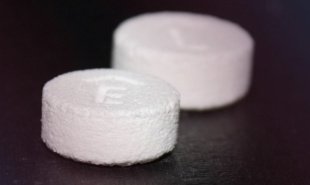
Earlier this year the FDA approved the first 3D printed drug, which is now set to enter production in Ohio from next month. Spritam, made by American pharmaceutical company Aprecia, can be taken by epileptics to reduce seizures. But as The Atlantic has reported, this technological advance is unlikely to have as great an impact upon pharmaceuticals, as 3D printing has had in other areas of medicine. Prosthetics, for example, is an area where the incredible reduction in costs has made prosthetic hands much more widely available. That is not to say the 3D printed pills will be without merit.
Pills are usually produced using a tableting machine, but in the case of Spritam, the ingredients are laid down one layer at a time, making the pills more porous and potent, enabling the ingredients to activate incredibly quickly. According to Aprecia, once digested, the tablets can disintegrate in less than ten seconds: this is particularly useful for treating epileptics. Additionally, Aprecia’s 3D printed pills are capable of containing very high doses, meaning patients may be able to reduce the number of pills they take — a small mercy for those with ongoing medical conditions that require them to take high numbers of medicines daily.
Theoretically, the innovation could enable the production of drugs to move out of distant factories and into hospitals, where doctors or pharmacists could print each patient’s dosage individually. But much more likely is that Aprecia and other pharmaceuticals will develop more medicines that are enhanced by the 3D printing process, but leave the infrastructure of the industry unchanged by manufacturing in factories.
What other treatments could be improved with high-dosage 3D printed pills?
Website: www.aprecia.com
Contact: contact@aprecia.com




